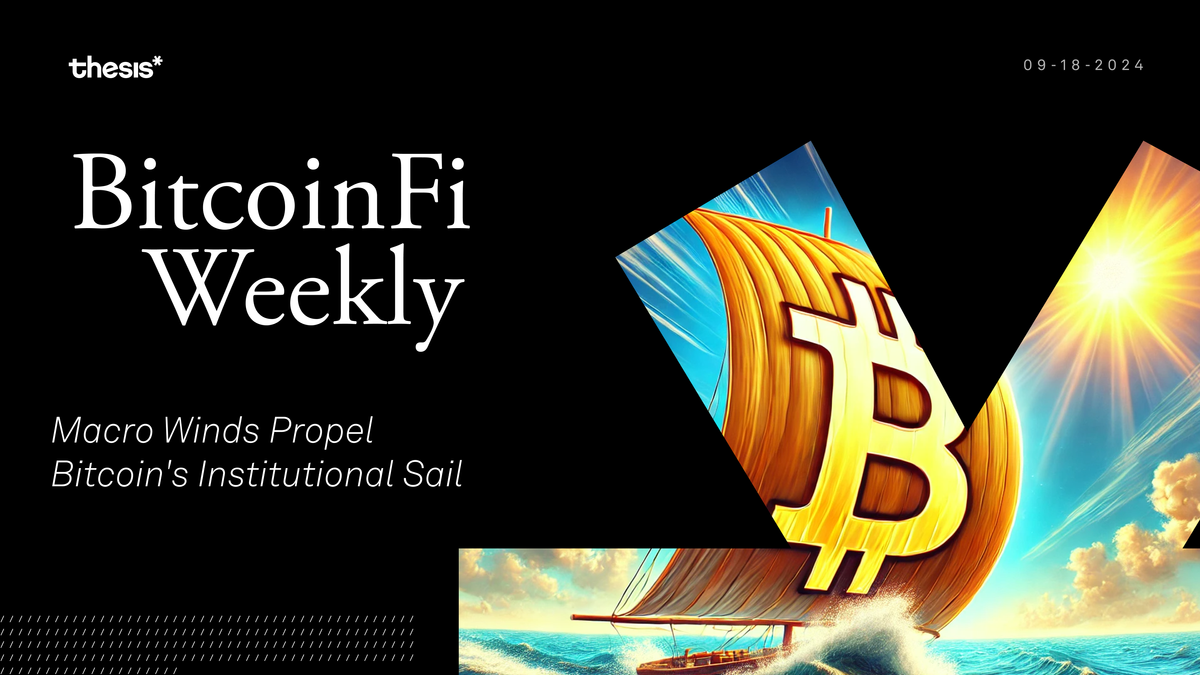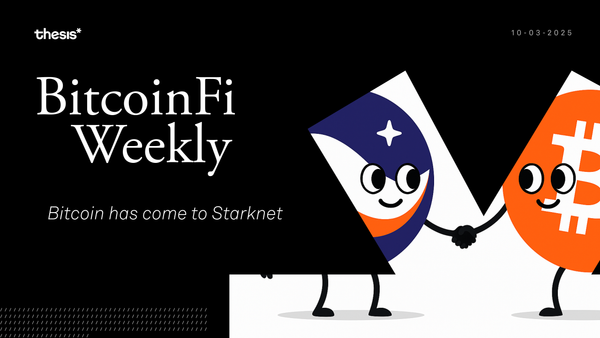Macro Winds Propel Bitcoin's Institutional Sail
This week, we saw CATNIP climb out of the bag, Fractal dreamed bigger than its britches, and AI miners found the key to profit.

Welcome to BitcoinFi Weekly. We cover where people use their BTC and what is changing in the Bitcoin world.
It’s funny how the universe conspires sometimes. One moment, the suits in Washington are slicing and dicing rates, trying to steer the economic ship before it capsizes, and the next, the folks at BlackRock are penning love letters to Bitcoin—something once considered the wild child of finance. So it goes. Yesterday's financial heresy becomes today's "unique diversifier." The same suits who once sneered at crypto are now scribbling nine-page manifestos on its virtues. While suits in Washington play economic Jenga with interest rates, the crypto-cowboys of BitcoinFi are busy lassoing lightning.
This, dear reader, is the story of Bitcoin's institutional awakening.
Here’s this week’s rundown:
🏦 Bitcoin’s Institutional Awakening
🐱 OP_CAT Let CATNIP Out of the Bag
⚠️Trouble in Fractal Paradise?
🔗Coordinate: A New Bitcoin Sidechain
🤖 AI Miners Create Disparity in Mining Revenue
🤝 tbtc Integrates on EigenLayer
Feature Piece: Bitcoin’s Institutional Awakening
The Federal Reserve’s decision to cut interest rates by 50 basis points wasn’t exactly unexpected, yet reverberated through markets. Equities spiked as if on cue, dancing to the Fed’s tune, and somewhere in the corner of the room, quietly humming its own melody, sat Bitcoin. As the Fed lowered rates to between 4.75% and 5.00%, BlackRock, the world’s largest asset manager, released a nine-page document showing how strong Bitcoin's position is. For years, Bitcoin has been framed as a risky, speculative asset—an outsider in a world dominated by traditional equities and bonds. But now, Bitcoin stands out as a “unique diversifier,” an asset that can weather fiscal, monetary, and geopolitical challenges unlike anything else on the market.
The timing is significant. The FOMC’s rate cut underscores the macroeconomic uncertainty looming over the U.S. economy. Inflation, still elevated, hasn’t been tamed despite aggressive monetary tightening. Job gains have slowed, unemployment has ticked up, and the Committee's confidence in reaching its 2% inflation target seems fragile at best. Clearly, the Fed is trying to preempt further economic slowdown, but with global risks stacking up, investors are scrambling to find safe havens.
With the macro winds howling like a banshee, institutions are rubbing their eyes and realizing, maybe, just maybe, Bitcoin might actually be the soundest money around. With a market capitalization north of $1 trillion and their own spot Bitcoin ETF accumulating over $21 billion in assets, BlackRock is now putting its entire weight behind the idea that Bitcoin’s role in financial markets is more than just speculative—it’s a hedge. Not just any hedge, but one that behaves differently from traditional assets, making it particularly valuable when uncertainty reigns. Yet, BlackRock acknowledges Bitcoin’s volatility. They admit that in the three years when Bitcoin underperformed, it wasn’t just a laggard—it was the worst-performing asset. But that’s only part of the story. In seven of the last ten years, Bitcoin outperformed all other major asset classes. More importantly, its correlation to U.S. equities, interest rates, and other macro factors has been short-lived and inconsistent. The asset behaves independently, reflecting global concerns over monetary policy, geopolitical instability, and fiscal deficits in a way no other asset does.
The report specifically notes Bitcoin’s lack of correlation with risk-on and risk-off assets. Investors often quickly categorize Bitcoin as “risk-on,” lumping it in with equities and other high-risk assets that flourish when economic optimism is high. But BlackRock pushes back on this narrative, arguing that Bitcoin’s fundamental drivers are distinct. While it’s true that Bitcoin is volatile and prone to sharp drawdowns—like the 7% dip in August tied to the unwinding of the Japanese Yen carry trade—it tends to rebound independently of equities. After that August drop, Bitcoin regained its losses within three days.
This is what BlackRock calls the “evolving prospects” of Bitcoin. Its price doesn’t just reflect short-term shifts in economic policy or stock market behavior; instead, it’s influenced by longer-term forces. Concerns over global monetary stability, geopolitical tensions, and U.S. fiscal health are emerging as primary drivers of Bitcoin’s adoption. And as these concerns grow, particularly around the sustainability of U.S. debt and deficits, institutional interest in Bitcoin is rising as a hedge against potential U.S. dollar depreciation.
BlackRock highlights that in the future, Bitcoin’s performance may become more directly tied to concerns over the global financial system’s stability rather than to the day-to-day gyrations of equity markets or interest rates. This is where Bitcoin’s scarcity and decentralization come into play. As a non-sovereign asset, Bitcoin is immune to the traditional counterparty and country-specific risks that define most financial instruments. There’s no central bank to manipulate its supply, no government to impose capital controls, no fiscal policy to affect its value. In an increasingly interconnected and unstable world, this isolation from global macro factors might be its greatest strength.
The convergence of macroeconomic instability and institutional interest is creating a perfect storm. The Fed is battling inflation, political tensions are rising globally, and the U.S. fiscal outlook is increasingly uncertain. Bitcoin’s unique qualities as a decentralized, scarce asset are becoming harder to ignore in this environment. BlackRock’s embrace of Bitcoin as a “unique diversifier” signals that the asset is no longer on the fringes of global finance. It’s firmly in the spotlight, with institutions like BlackRock leading the way.
BitcoinFi Updates
OP_CAT Let CATNIP Out of the Bag
The introduction of CATNIP, a new Bitcoin-native token protocol, seeks to resolve longstanding issues with token protocols like Runes and BRC-20s. CATNIP leverages Bitcoin’s OP_CAT recursive covenants, providing true Bitcoin-native tokens that integrate directly with Bitcoin's scripting system.
CATNIP's most significant improvement is its ability to allow partially filled orders, so users no longer have to split UTXOs ahead of time. It enables bids, creating more flexibility for both buyers and sellers. Perhaps most importantly, it introduces the potential for on-chain Automated Market Makers (AMMs) and liquidity pools, though much work needs to be done before these can be realized. CATNIP isn’t live yet—its launch is contingent upon OP_CAT being activated on the Bitcoin mainnet.
Trouble in Fractal Paradise?
Days after launch, new Bitcoin scaling protocol Fractal has hit major snags. Perhaps most alarming is the trajectory of Fractal Bitcoin's blockchain size. With transaction activity surging, blocks are nearly at their maximum capacity of 4 MB, and the chain is quickly approaching a problematic scale. If the current growth rate holds, Fractal Bitcoin’s blockchain will surpass Bitcoin’s ~600 GB size by November 2024 and could reach a staggering 1.6 TB by early 2025. This rate of expansion could mirror problems previously seen with Bitcoin SV, where the blockchain becomes too large for most individuals to run full nodes, potentially centralizing control of the network.
Additionally, there are some troubling signs on the security front. Early reports indicate that Fractal Bitcoin nodes are vulnerable to significant security risks due to poorly configured settings. Issues, like hardcoded RPC credentials and permissive node configurations, expose node operators to potential attacks.
Coordinate: A New Bitcoin Sidechain
Coordinate is a Bitcoin-native sidechain developed by Anduro. At its heart, Coordinate is designed to provide Bitcoin users with scalable and flexible transaction capabilities without compromising on security or decentralization. The sidechain introduces a suite of features that could potentially reshape how we interact with Bitcoin. Central to this is cBTC, Coordinate's native asset that's pegged to and redeemable 1:1 for Bitcoin. This innovative approach allows users to enjoy the familiar value and reliability of Bitcoin while benefiting from enhanced flexibility and lower fees.
One of Coordinate's most critical components is its hybrid consensus model, which merges the security of Bitcoin’s PoW with the Strong Federation model. This fusion results in reorg-resistant transactions, providing users with an added security layer and stability. The use of SHA-256 merge-mining not only bolsters the network's security but also opens up new revenue streams for Bitcoin miners, aligning incentives across the ecosystem.
One thing peculiar to note: on their intro blog, Coordinate mentions that it will offer a “premium transacting feature” that provides MEV-resistant transactions with a reverse auction fee market, ensuring fast finality in about a minute. It is specified that this feature will only be available to premium users, though no details are shared beyond this.
AI Miners Create Disparity in Mining Revenue
A new Bitcoin mining trend is emerging: AI-focused mining. According to a recent report by Bernstein, companies such as Core Scientific, IREN, and Terawulf have outshined their rivals by offering a diversified approach that includes AI-driven infrastructure alongside Bitcoin mining.
The appeal of AI-focused miners lies in their ability to navigate the choppy waters of the crypto markets with greater agility. Additionally, these miners are building robust data center infrastructures that can tap into the burgeoning AI sector. This dual-purpose approach gives investors a sense of security, reflected in better valuation multiples and more predictable revenue forecasts. IREN stands out as a particularly intriguing case. Bucking the trend of slower hash rate growth among AI-focused miners, IREN has quadrupled its hash rate year-over-year. The company's ambitious plans are to double both its GPU fleet and hash rate by the end of the year, coupled with projections that AI cloud services will contribute 10% to its earnings.
On the other side of the coin, traditional Bitcoin mining giants like Marathon, Riot Platforms, and CleanSpark are doubling down on their core business. These companies have opted to retain a significant portion of their Bitcoin holdings on their balance sheets. Instead of selling off mined coins to fund operations, they have held 100% of their production since August 2024 and raised capital through other means, including equity dilution. These large miners are focused on expanding their market share in Bitcoin mining, viewing AI as a distraction rather than a complementary business opportunity. In stark contrast, AI-focused miners are adopting an entirely different strategy. These companies typically sell 100% of their Bitcoin production to fund operations, often due to internal policies or debt covenants that prevent them from holding Bitcoin as a treasury asset. For them, Bitcoin is simply a byproduct of running data centers, not the core of their business. They see themselves as data center operators first and foremost, with Bitcoin mining serving as a secondary revenue stream.
The strategy contrast between traditional Bitcoin miners and AI-focused operators highlights a growing disparity in the industry. While Bitcoin miners like Marathon and Riot are betting heavily on Bitcoin’s long-term price appreciation, AI-focused miners are positioning themselves to capitalize on the exponential growth of the AI sector, creating a unique bifurcation in the market.
tBTC 🤝 EigenLayer
tBTC continues to rise in market cap & mindshare as Threshold Network announced that tBTC is now supported for restaking on EigenLayer. Restaking enables assets to secure multiple protocols simultaneously, opens new earning opportunities for Bitcoin holders, and unlocks new frontiers for BitcoinFi.
Threshold Network DAO is offering up to $45,000 in incentives for users who deposit tBTC into EigenLayer over the next three months. These rewards, in the form of T tokens, make tBTC the first incentivized Bitcoin asset available for staking on EigenLayer.
Closing Thoughts
Here we are, watching the macro winds howl, inflation climbing like a vine, and institutions like BlackRock quietly realizing that Bitcoin might just be the anchor in the storm. This week, we saw CATNIP climb out of the bag, Fractal dreamed bigger than its britches, and AI miners found the key to profit. It's a brave new world where Bitcoin plays the role of both jester and sage, dancing on the grave of financial orthodoxy while whispering sweet nothings about being a "unique diversifier" into the ears of trembling institutions. It's enough to make a person wonder if we're all just characters in some cosmic tragic comedy, our fates tied to the whims of an algorithm no one fully comprehends.
Thank you for tuning in to this week’s BitcoinFi Weekly. See you next week.
If there's a topic you’d like us to cover or have questions, reach out at [email protected].
Learn more about Mezo at the following channels:
👾 Discord: https://discord.mezo.org
🕊 X: https://twitter.com/MezoNetwork
🖥 Website: https://mezo.org
🏦 Deposit Portal: https://mezo.org/hodl
ℹ️ Docs: https://info.mezo.org





